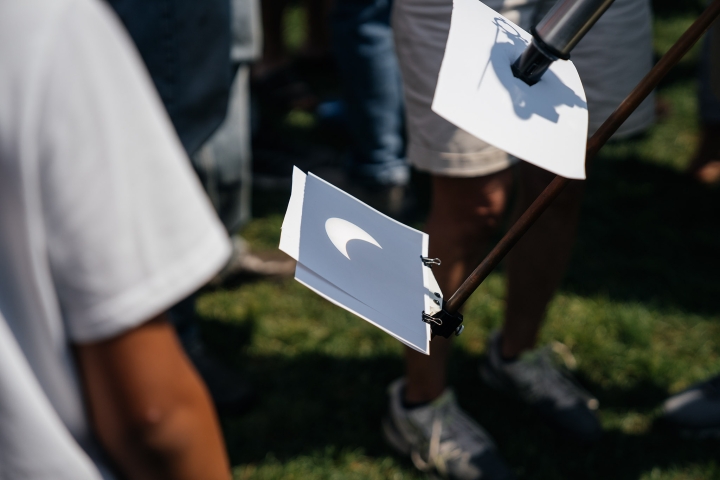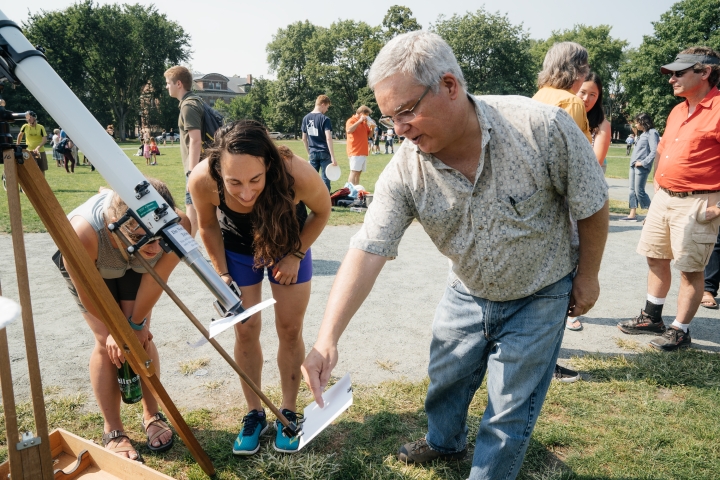With a total solar eclipse poised to pass over New Hampshire on April 8 for the first time in 65 years, folks are abuzz at Dartmouth and in the towns north of campus that will experience the moon’s full coverage of the sun.
The path of totality—the swath in which the moon fully obscures the sun—will come in from northern New York in the afternoon, casting its shadow over Vermont for the first time since 1932 before tracing across our home state north of the White Mountains (or U.S. Route 2, for the initiated).
Hanover is just south of totality. Though local weather may be a gamble, the eclipse will begin here at 2:15 p.m., hitting a peak of more than 98% of totality at 3:28 p.m. before waning back to normal by 4:38 p.m.
If that seems oddly specific, it’s because solar eclipses are easy to track, says Professor of Physics and Astronomy John Thorstensen. He discussed the science of them in a series of videos Dartmouth produced ahead of the 2017 eclipse, which was partially visible from New England—about 50% to 70% of totality—and the first to be visible in the United States since 1979.
“One of the remarkable things about eclipses is that, unlike everything else in nature, they are remarkably predictable,” Thorstensen says. “We know what’s going to happen centuries ahead of time. It’s just gravity and inertia running the whole show, so it’s all predictable.”
Thorstensen has seen three total eclipses since 1972. For the 1979 eclipse, he and his college friends raced in an unreliable Volkswagen bus from Berkeley, Calif., to Helena, Montana, to be in the path of totality. The van broke down every 200 miles. The harried posse barely made it to a prairie hillock where they watched the encroaching shadow engulf the plains fringed by sharply rising mountains.
The eclipse, of course, was right on time. “You could see it coming. The hills started getting dark really fast. This ill-defined shadow is moving across the plain then, boom, it’s total,” Thorstensen recalls. “Just a ring of light around the moon. It’s a truly unique spectacle of nature and should definitely be on everyone’s bucket list.”
The Rockefeller Center for Public Policy and the Social Sciences will bring that experience to campus April 8 with a viewing event on the Green from 2 p.m. to 4 p.m. The gathering is free and open to the public and co-sponsored by the Office of the Provost. The Rockefeller Center will provide eclipse glasses and the Department of Physics and Astronomy will have telescopes for people to safely view the eclipse. The center intends for the event to be the local hub for the eclipse, with plans to include refreshments from local vendors.
Starting March 25, people wanting to binge the backstory of eclipses can head over to the first floor of the Baker-Berry Library to peruse a display featuring books from the library’s collection on the scientific, historical, social, and cultural significance of eclipses. A related research guide also will provide information about the April 8 path of totality and on safely viewing the eclipse.
The library also plans to lead into the eclipse with a speaker series featuring Dartmouth researchers called, “Steller Sessions: Exploring Research Involving Eclipses.” Details will be posted to the Baker-Berry events calendar as they’re available.
Series speakers will include Professor of Physics and Astronomy Kristina Lynch and PhD candidate Magdalina Moses. Lynch, Moses and students in the Lynch Lab constructed data-collection instruments for three rockets that NASA will launch from Virginia on April 8 for the second phase of its Atmospheric Perturbations around the Eclipse Path, or APEP, mission, which is collecting data on how Earth’s lower-altitude ionosphere responds to the eclipse.
The Lynch Rocket Lab provided instruments for the mission’s first phase rockets that launched from New Mexico during the Oct. 14 annular eclipse. The Dartmouth team is analyzing data from their devices for signatures of ion-temperature changes that will be shared with the larger project team.

Closer to home, Professor of Physics and Astronomy Brian Chaboyer and Assistant Professor of Physics and Astronomy Elisabeth Newton are taking a group of graduate students and about 30 undergraduates—who are enrolled in the courses Stars and the Milky Way and Habitable Planets—to the Fairbanks Museum in St. Johnsbury for the Sun+Moon+You eclipse event. The Dartmouth students will set up solar-viewing telescopes and teach members of the community about the dynamics of solar eclipses.
“Students will reinforce their understanding of the relative movements of the sun, moon and Earth during this experience,” Chaboyer says. “We cover these topics in class, as well as subjects such as the reasons for the seasons, phases of the moon, and eclipses. By teaching others about these concepts, and viewing the eclipse themselves, students will really reinforce their understanding of these topics.”
In the age before satellite-based astronomy, eclipses provided scientists with a critical understanding of astronomical mechanics and physics, Thorstensen says. Eclipses first allowed scientists to observe and study the super-hot ring of reactive atoms surrounding the sun known as the corona.
Hanover native Charles Augustus Young, who graduated from Dartmouth in 1853 and served as a professor from 1866 to 1877, made among the first spectroscopic measurements of the solar corona and the chromosphere—the second layer of the sun’s atmosphere—by observing solar eclipses. Young was a renowned astronomer in his time and his findings were fundamentally important for eventually showing that the gases around the sun are much hotter than the solar surface itself, Thorstensen said.
Thorstensen, who studies eclipses beyond our solar system, says that today, eclipses provide a basis for discovering new planets by helping us understand the effect on light as these planets pass in front of their stars.
“Eclipses in solar physics resonate across a wide variety of stellar and planetary physics. None of them exist in isolation. Though, it’s space, so you can say it exists in a vacuum,” Thorstensen says.
His suggestion is for people viewing the April 8 eclipse to wear eye protection—he’s had luck with shade 14 welder’s glass—and put down the phone. You’ll remember the experience without a photo, Thorstensen says.
“It’s an experience for which you don’t want stuff in your way,” Thorstensen says. “There’s something inexpressibly strange about having the sun go away in the middle of the day. There is nothing like seeing a total solar eclipse. It has a visceral effect.”

